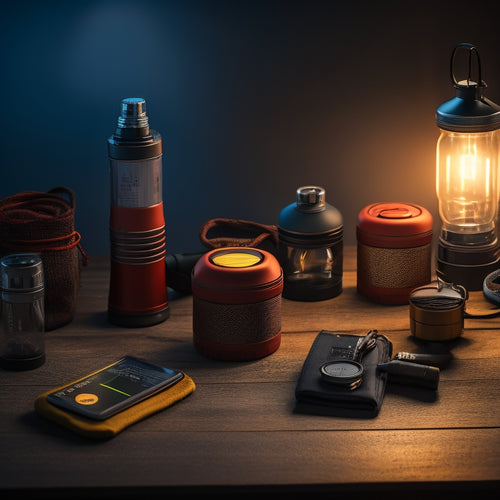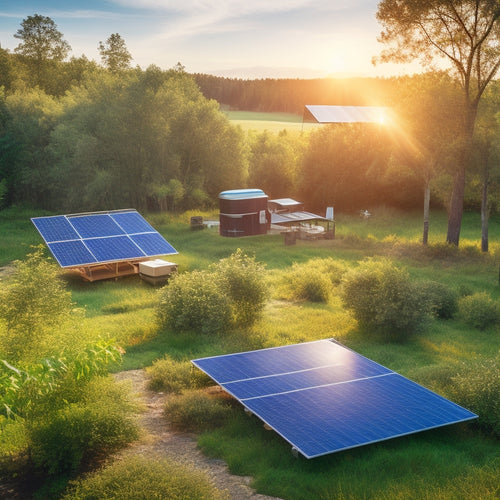
Audit Your Home for Maximum Efficiency
Share
You're likely losing up to 30% of your home's energy efficiency due to hidden air leaks, outdated appliances, and inefficient systems, which can be easily identified and addressed through a thorough home audit. Start by identifying energy-draining appliances, sealing air leaks, and inspecting and upgrading insulation. Optimize lighting and windows, check heating and cooling systems, and analyze water heater efficiency. Don't forget to detect moisture and mold issues, which can lead to health risks and energy waste. By auditing your home's energy efficiency, you'll be well on your way to reducing energy consumption and saving on utility bills - and that's just the beginning.
Key Takeaways
- Conduct an energy audit to identify areas of high energy usage and prioritize upgrades for maximum efficiency.
- Seal air leaks and add insulation to walls, floors, and ceilings to reduce energy waste and lower utility bills.
- Optimize lighting and windows by installing energy-efficient bulbs and window treatments to reduce artificial lighting needs.
- Regularly inspect and maintain heating and cooling systems, water heaters, and drainage systems to prevent energy waste and extend system lifespan.
- Identify and address moisture and mold issues through regular inspections, humidity control, and proper drainage to prevent health risks and property damage.
Identify Energy-Draining Appliances
Among the most important contributors to your home's energy inefficiency are the appliances that drain energy without you even realizing it. Many appliances continue to consume power even when turned off but still plugged in, a phenomenon known as standby power consumption.
To optimize your home's energy efficiency, it's vital to conduct an energy audit and identify areas of high energy usage. You can start by examining your appliance lifecycle, taking note of their age, usage, and energy consumption patterns.
Consider replacing outdated appliances with energy-efficient upgrades, such as LED bulbs and Energy Star-rated devices. By doing so, you can greatly reduce your energy waste and lower your utility bills.
Seal Air Leaks and Gaps
You'll need to find hidden leaks in your home's walls, floors, and ceilings, as they can greatly impact your energy efficiency.
Next, inspect your window frames for gaps and cracks, as these can let heated or cooled air escape.
Additionally, incorporating energy storage solutions like deep cycle batteries renewable energy storage can help optimize your energy usage and reduce reliance on fossil fuels.
Find Hidden Leaks
When performing a home efficiency audit, identifying hidden air leaks and gaps is essential to optimizing energy consumption and reducing energy bills. You'll want to inspect areas where air can escape, such as electrical outlets, switches, and plumbing fixtures. Use thermal imaging to detect temperature differences that can indicate air leaks.
| Hidden Leak Location | Detection Method |
|---|---|
| Behind electrical outlets | Thermal imaging or smoke test |
| Around plumbing fixtures | Visual inspection, moisture detection |
| Near HVAC units | Thermal imaging, pressure test |
Regular plumbing maintenance can also help identify hidden leaks. Check for signs of water damage or corrosion around pipes and fixtures. By finding and sealing these hidden leaks, you can notably reduce energy loss and save on your energy bills.
Inspect Window Frames
Having sealed hidden air leaks behind electrical outlets and around plumbing fixtures, it's time to turn your attention to inspecting window frames.
Check the condition of the frames, looking for signs of wear, damage, or decay. Different window frame materials, such as wood, vinyl, or aluminum, have unique characteristics that affect their energy efficiency.
Inspect the frames for gaps or cracks that allow air to escape or enter. Check for loose or missing caulking, weatherstripping, or glazing compounds.
Consider applying energy efficient treatments, such as low-e coatings or window film, to reduce heat transfer and minimize energy loss.
Identify any areas that require repair or replacement to guarantee your windows are functioning efficiently.
Seal Electrical Outlets
Efficiency begins with attention to detail. When it comes to sealing electrical outlets, a small oversight can lead to significant energy losses.
Check your outlets for any gaps or openings, as these can allow heated or cooled air to escape. To seal these gaps, install outlet covers, which are specifically designed to fit snugly over outlets.
These covers are inexpensive and easy to install, making them a simple yet effective solution. By sealing your electrical outlets, you can prevent energy losses and reduce your energy consumption, leading to significant energy savings over time.
Inspect and Upgrade Insulation
You'll want to inspect your walls and ceilings to guarantee they're properly insulated, as gaps and leaks can greatly reduce your home's energy efficiency.
Check for any signs of damage, gaps, or settling that may have compromised the insulation's effectiveness.
Consider the importance of energy efficiency measures in off-grid systems, such as LED lighting and Energy Star appliances, which can greatly reduce energy needs.
Pay particular attention to areas around electrical outlets, switches, and windows, where insulation is often compromised.
Walls and Ceilings Matter
Inspect your walls and ceilings to uncover hidden opportunities for energy savings. The type of wall materials you have can greatly impact your home's energy efficiency.
For instance, walls with high thermal mass, such as concrete or brick, can absorb and release heat, reducing the need for heating and cooling. On the other hand, walls with low thermal mass, like wood or vinyl, may require more energy to maintain a comfortable temperature.
Additionally, consider the ceiling colors and finishes, as darker colors can absorb heat, while lighter colors can reflect it.
Insulation Gaps and Leaks
As you've assessed the thermal properties of your walls and ceilings, it's now time to turn your attention to the insulation that separates your living space from the outdoors.
Inspect your insulation for gaps and leaks, which can lead to thermal bridging and reduced energy efficiency. Check for torn, worn, or missing insulation materials, and identify areas where insulation may have settled or been damaged.
Pay particular attention to joints, seams, and corners, where insulation is most prone to gaps.
Consider upgrading your insulation materials to more efficient options, such as spray foam or fiberglass, and guarantee a proper seal to prevent air leaks.
Optimize Lighting and Windows
Optimize Lighting and Windows
You can greatly reduce energy consumption by optimizing lighting and windows. Start by evaluating your window orientation and natural light availability.
Consider installing window treatments like blinds, shades, or awnings to control the amount of natural light entering your home. This will help reduce the need for artificial lighting during the day.
Next, examine your lighting fixtures and replace inefficient bulbs with LEDs or CFLs, which consume considerably less energy.
Additionally, install occupancy sensors or timers to guarantee lights are turned off when not in use.
Check Heating and Cooling Systems
With your heating and cooling systems accounting for nearly half of your energy expenses, it's crucial to guarantee they're operating at peak efficiency. A smart thermostat can help you regulate temperatures and optimize energy usage. Don't forget to perform seasonal maintenance on your systems, including cleaning filters and inspecting ducts.
| System | Seasonal Maintenance | Benefits |
|---|---|---|
| Heating | Clean filters, inspect ducts | Improved air quality, increased efficiency |
| Cooling | Check refrigerant levels, clean coils | Reduced energy consumption, extended system lifespan |
| Both | Schedule professional tune-ups | Extended system lifespan, reduced repair costs |
Analyze Water Heater Efficiency
Behind the scenes of your daily routines, your water heater is working tirelessly to provide hot water for showering, washing dishes, and doing laundry, accounting for a significant chunk of your energy expenses.
To optimize its efficiency, check the water temperature setting, which should ideally be between 120°F and 140°F. A lower temperature can lead to bacterial growth, while a higher temperature wastes energy.
Next, inspect the water heater's maintenance schedule, ensuring regular checks for leaks, sediment buildup, and worn-out parts. A well-maintained water heater can reduce energy consumption and prolong its lifespan.
Detect Moisture and Mold Issues
As you've confirmed your water heater is running efficiently, it's time to turn your attention to another potential energy drain and health hazard: moisture and mold issues in your home.
Moisture detection is key to mold prevention, so start by inspecting areas prone to dampness, such as basements, crawl spaces, and bathrooms.
Check for water stains, warping, or musty odors, which can indicate hidden moisture issues. Use a hygrometer to measure humidity levels, aiming for 30-50%.
Inspect your home's exterior, verifying proper drainage and sealing any gaps or cracks.
Frequently Asked Questions
Can I Perform an Energy Audit Myself or Do I Need a Professional?
You can perform a DIY energy audit, but a professional's knowledge may be necessary for a thorough assessment. Start by identifying air leaks, inspecting insulation, and checking for energy-efficient appliances to get a sense of your home's energy usage.
How Often Should I Replace My Air Filters to Maintain Efficiency?
"An ounce of prevention is worth a pound of cure." You should replace your air filters every 1-3 months, depending on filter type and usage, to maintain efficiency; create a maintenance schedule to guarantee you don't forget, and consider upgrading to high-efficiency filters for peak performance.
Are Energy-Efficient Appliances Worth the Higher Upfront Cost?
You'll likely recoup the higher upfront cost of energy-efficient appliances through long-term energy savings, which can offset the initial investment and provide substantial financial benefits over the appliance's lifespan.
Can I Get Rebates or Incentives for Making Energy-Efficient Upgrades?
You can investigate energy rebates, tax incentives, and utility programs offering discounts for energy-efficient upgrades, while government grants fund home performance projects, and efficiency assessments help identify areas eligible for these incentives.
How Long Does It Take to See a Return on Investment From Efficiency Upgrades?
You're wondering when you'll break even on those energy-efficient upgrades. The answer lies in the payback period, which varies depending on the upgrade and location. On average, you'll start seeing cost savings within 5-10 years, but it can be as little as 2-3 years for some improvements.
Related Posts
-

Is This the Future of Alternative Energy Systems
Yes, alternative energy systems are shaping the future of energy. Innovations in solar and wind technologies are driv...
-

Best Solar Powered Flashlights for Emergency Situations
When you're choosing the best solar-powered flashlights for emergency situations, focus on their brightness, battery ...
-

Top Off Grid Solar Batteries for Renewable Energy
When seeking top off-grid solar batteries for renewable energy, consider options with advanced battery chemistry, suc...


